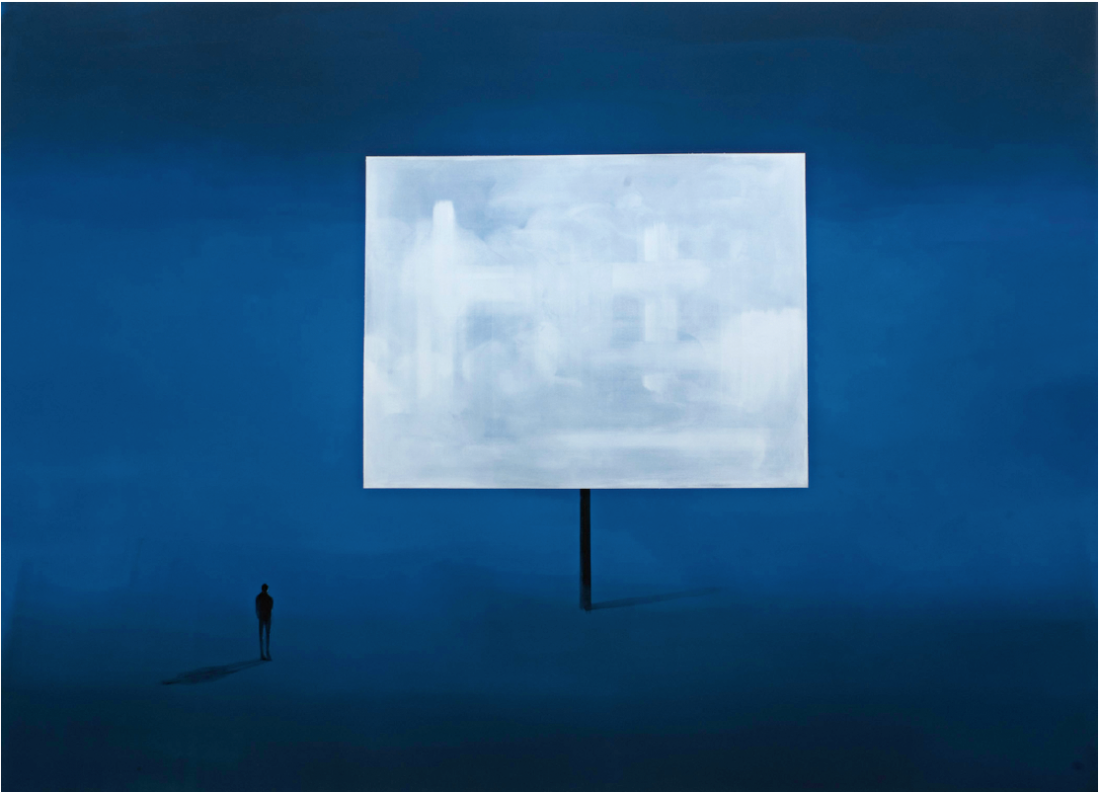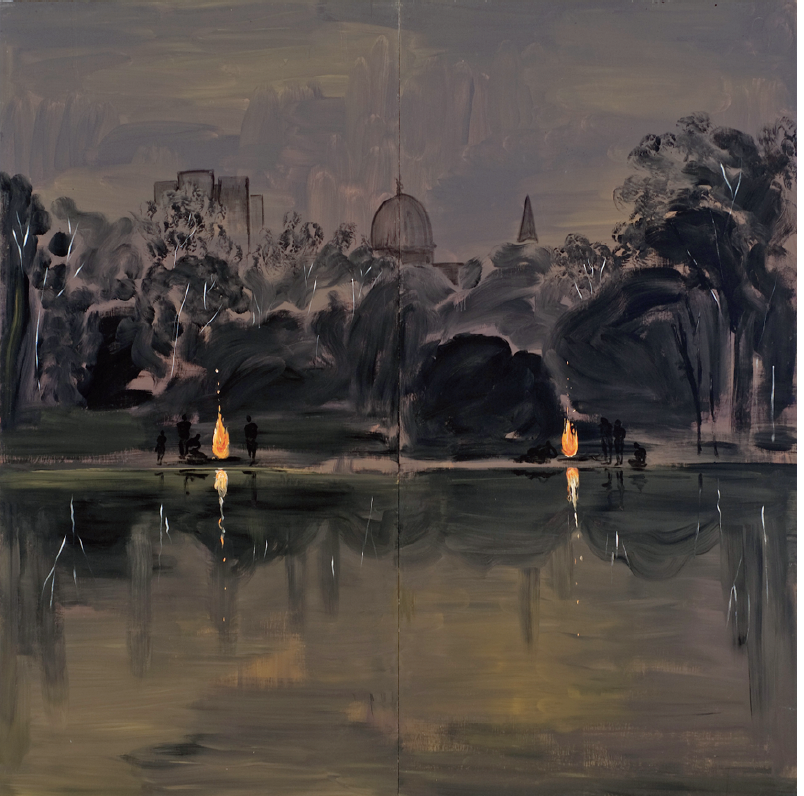Wanda Koop
“On the Edge of Experience” is a retrospective of Wanda Koop’s work from the last 30 years. Significant to the local community because she is an artist with a passion for large-scale art making, global exchanges and street-front art programs, Koop’s exhibition is a complex affair. The retrospective culls from her international and national exhibitions and provides context through the presentation of 3d models of past exhibitions, process-oriented items, research from her studio, photographic views, new paintings and a collaboration with choreographer Jolene Bailie and others in the performance Hybrid Human.
A retrospective is a tricky business: what to include, what to diminish, how to show rather than tell, how to structure the viewer’s movements and gaze, and how to balance old and new, particularly when the artist is at the height of her synthetic abilities. Curator Mary Reid of the Winnipeg Art Gallery carefully developed the project for three years, with curator Josée Drouin-Brisebois of the National Gallery of Canada curating the video components. Given Koop’s interests in articulating space through installation, monumental canvases and her penchant for thinking and refining in series, one senses she could have taken over the entire gallery. The exhibition in Winnipeg precedes the National Gallery opening in Ottawa.
“On the Edge of Experience” unfolds in three galleries located in the point of this 1970s building, with the Skylight Lounge and the main-floor Ferdinand Eckhardt Hall enlisted to bolster and expand the display. In these spaces, the viewer becomes aware of the variety of Koop’s imagery, her rich facility with colour and brushwork, and her interest in sign systems. Large Chinese opera masks, a baby’s face, a helicopter hovering in a sunset sky, a jockey on a horse. Many paintings from the opening salvo are from the “No Words,” 1991, series, each comprising two four-by-eight-foot plywood sheets painted as one image. They fascinate through their simplicity of concept, mastery of execution, variety of paint application, resonant cultural motif and restraint. Koop synthesizes through abstraction, distilling cultural knowledge in visual form. This prelude to the exhibition space proper sets up abstraction and distillation as key components of her style.

Wanda Koop, Untitled, 2009–2010, from “Hybrid Human,” acrylic on canvas, 305 x 396 cm. Collection of the Winnipeg Art Gallery. Gift of the BMO Financial Group. Photograph: Bruce Spielman. Courtesy the Winnipeg Art Gallery.
The largest room is filled with big paintings from projects over the years. These are not trivial matters. Excerpts from “Sightlines,” 1999–2001, “Green Room,” 1994, and other bodies of work play with the notion of how lens magnification, digital technologies, broadcast media and aerial photography shape our seeing through war and through leisure. Vestiges of these devices linger as projections over the landscape. Surveillance of the landscape via technology denies the romanticized fulfillment through paint and distant vistas where Koop is so brilliantly capable. The exhibition shows Koop at her full power as an artist, and the viewer wonders at the stained and shadowed landscapes made with such an economy of means.
From the exhibition’s main area, the viewer glimpses a climbing dancer ascending the screen, a video installation that is the backdrop for the Hybrid Human performance. Behind the giant projection are Koop’s most recent paintings, where a tiny viewer in black considers rectangular screens or paintings that intersect the picture plane at various angles and degrees, as if in contemplation of painting/the monitor/the big picture. The newest paintings float in front of walls, insinuating their differences from Modernist easel painting. The experience of the large paintings is given through sparse selection, allowing ample room to absorb and consider their effects.
In contrast to the airy atmosphere of long sightlines and distant views, density is the guiding principle in the adjacent gallery. Here, salon-style hanging mixes sizes and series, painting and video, from ankle height to ceiling. Bits of information, shifts of colour harmonies, screaming fluorescents, pixillated bodies, a monster, more fire, an implicit feminist critique, outrage, beauty. The points are all visual and mostly rectangular. Signage has been kept to a minimum. There are museum-style laminated placards for the earnest if a title or date is required. Within this construct of the studio, there are 10 large Plexi-covered tables. These provide a glimpse into Koop’s processes from books and objects made by others, post-it note research, sketch books and photograph collections. Koop does prodigious research. She can draw. She is inspired by design and colour as they perform and enact social and cultural codes and inequities.

Wanda Koop, Native Fires, 1987–1989, from “No Words,” acrylic on plywood, 244 x 244 cm. Collection of the Art Gallery of Southwestern Manitoba, Manitoba Arts Council Art Bank, Brandon, Manitoba. Photo: Ernest Mayer, WAG. Courtesy the Winnipeg Art Gallery.
Koop works with space and scale in ways that force us to imagine locales that are on the threshold and extension of the body’s limits. The views just beyond our grasp are frequently pictured here, whether they are the newly imagined hybrid of technology and human or the glimpsed vista at the periphery of our vision. Her ability to abstract allows us to see some of society’s most invisible principles of detachment and alienation. What does it mean, for example, to be able to view planes and helicopters full on and in mid-flight? How are the photographic technologies of surveillance and views of the landscape shot through by militarism? We are witness to Koop’s questioning as we are drawn in by the beauty of her land, sea and urbanscapes. Her answers are neither romantic nor realist but something representing new visual knowledge.
The work is an example of painting’s existential ability to mimic, reduce and surprise. But technology in the form of the screen, the photographic lens, the sensing device, digital grids, binary codes and militarism are her great interlocutor. These incursions take on increasingly significant roles, and she makes this experience compelling and somehow just out of reach through her choice of subject, colour, scale, installation and consummate technique.
Reid and Koop have seized the opportunity to explain past production through the inclusion of remarkable maquettes made for the exhibition by Stephen Hunter. These indicate multiple past exhibitions constructed to scale in tabletop wooden models complete with miniature paintings. They are a delight, as is the catalogue, which includes a thorough discussion of her work, extensive documentation and an excellent essay by Robin Laurence on Koop’s development in the context of Canadian painting and the feminist project. I like the way it all comes together, neither realist nor romantic but wholly original. ❚
“Wanda Koop…On the Edge of Experience” was exhibited at the Winnipeg Art Gallery from September 11 to November 21, 2010.
Amy Karlinsky is a Winnipeg-based writer.

